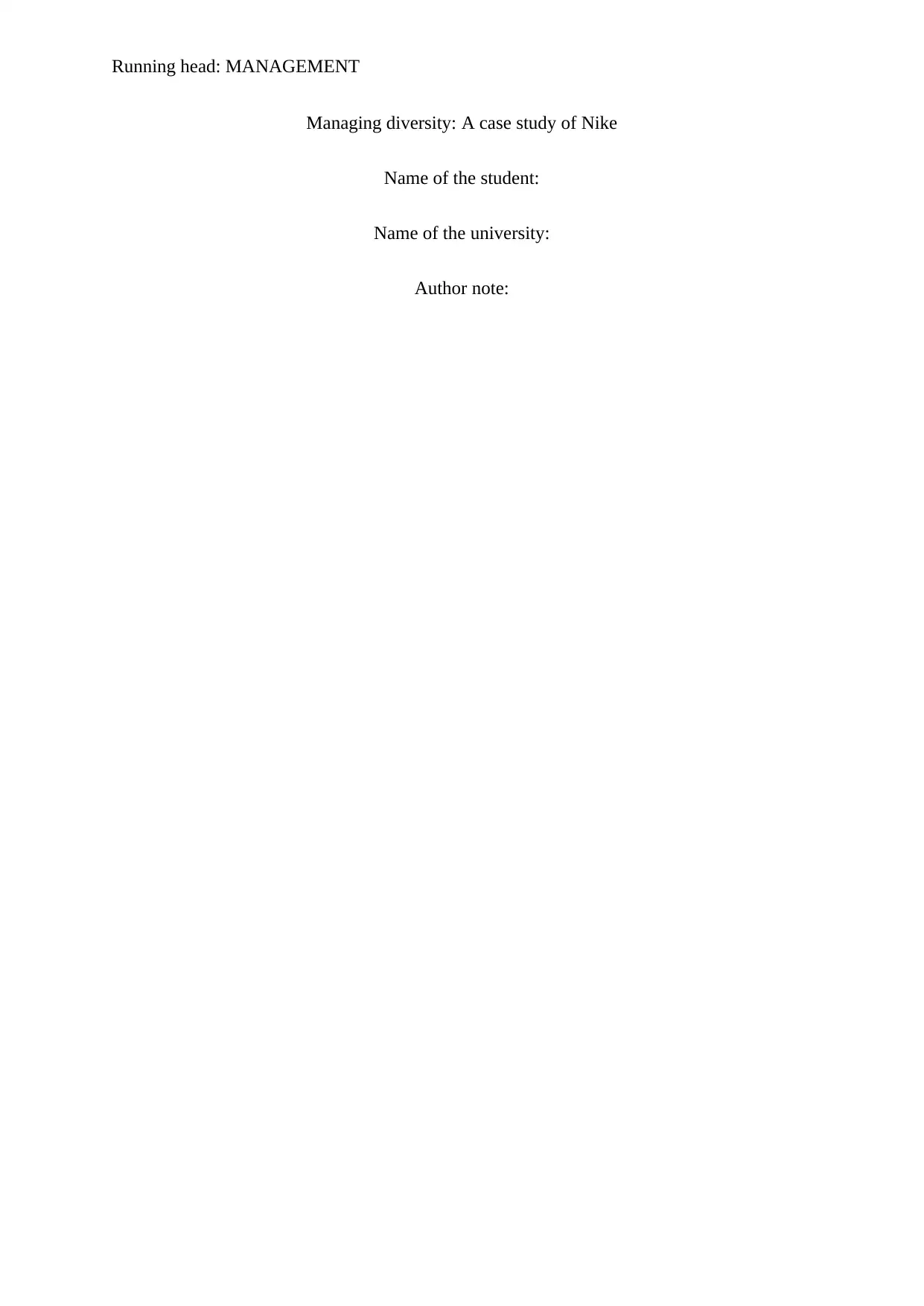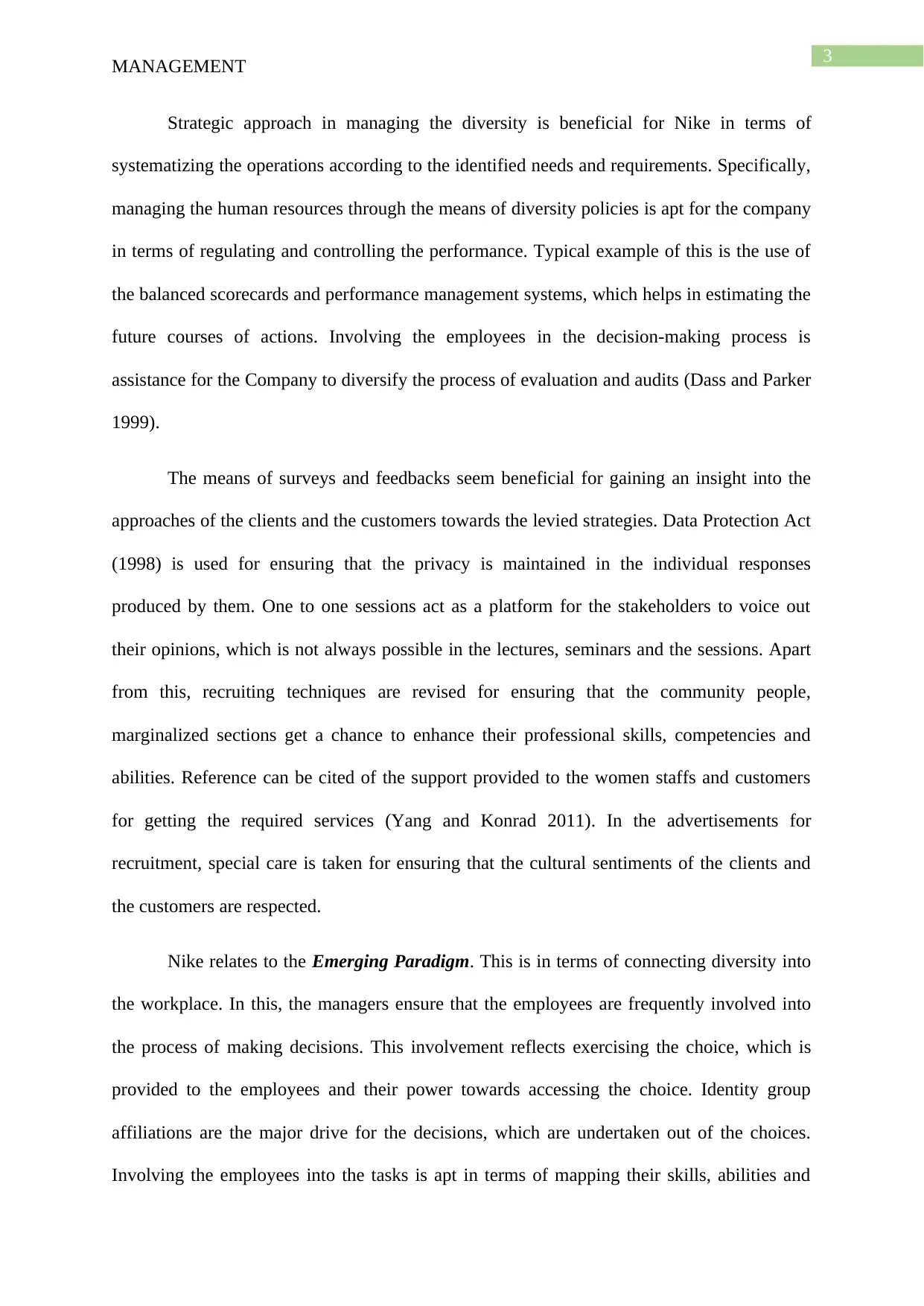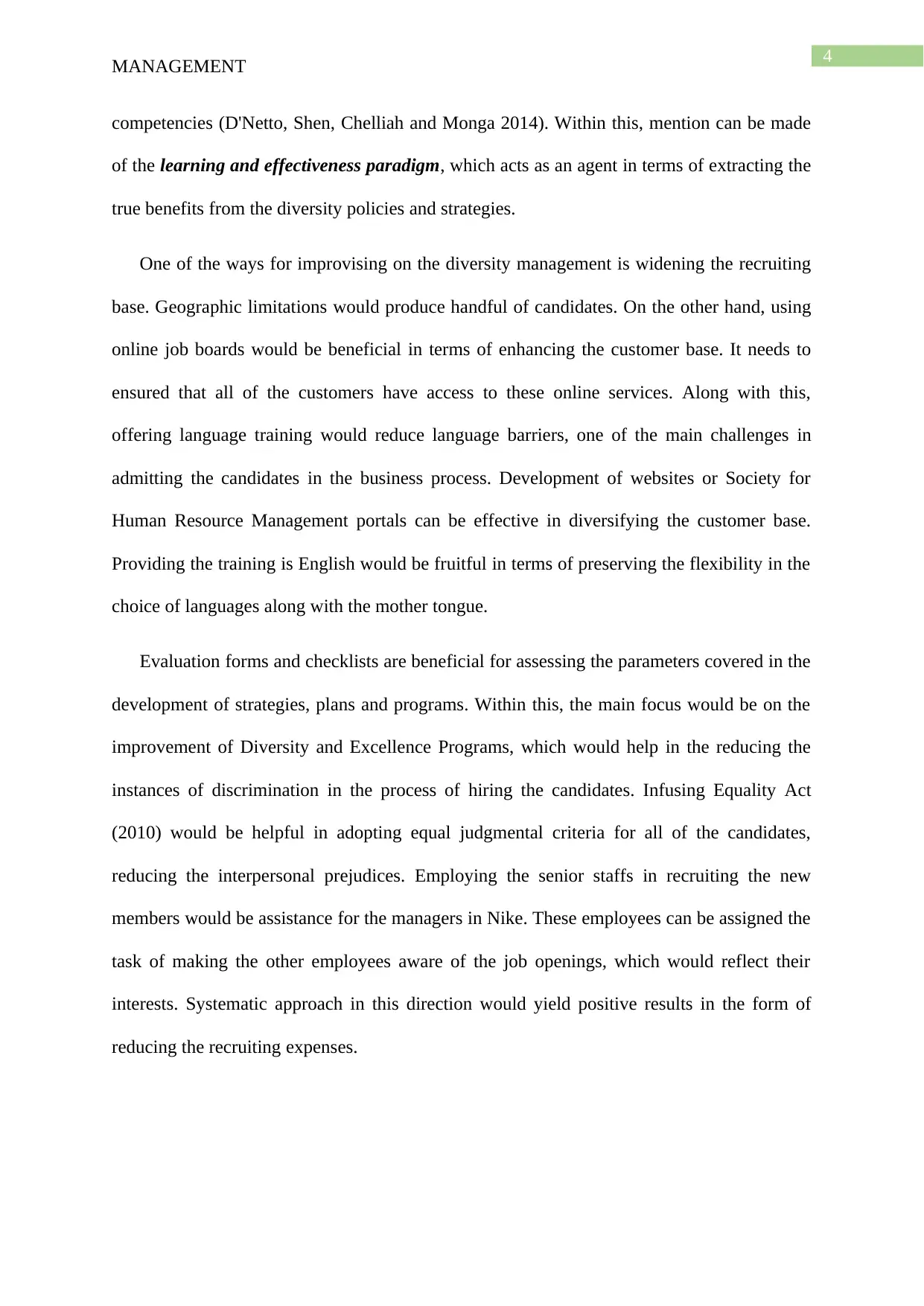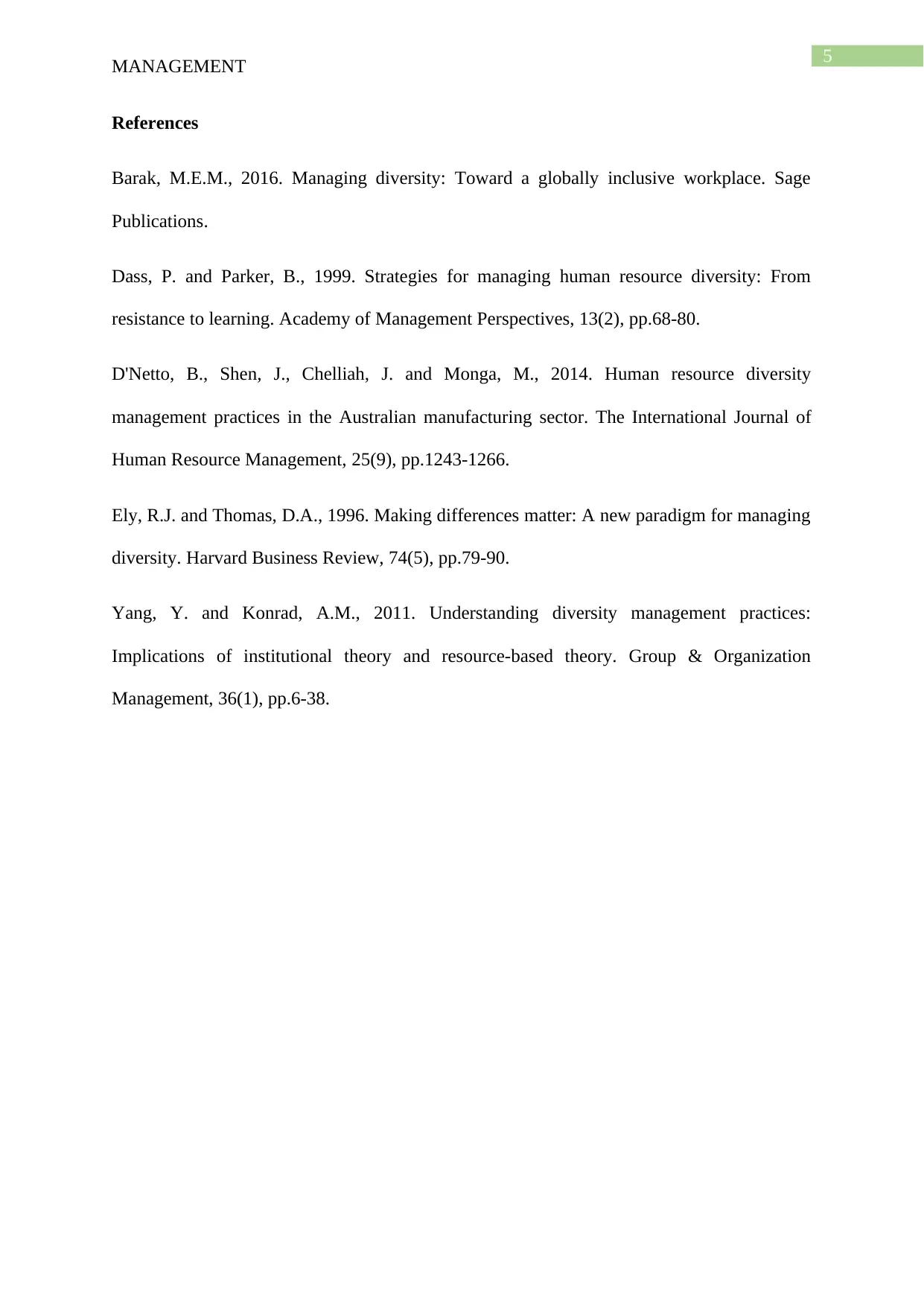BUSN 2044 S1: Managing Diversity at Nike Case Study
VerifiedAdded on 2022/12/27
|6
|1532
|75
Essay
AI Summary
This essay provides a case study analysis of Nike's diversity management practices. It explores how Nike fosters an inclusive workplace culture through various initiatives. The essay highlights the importance of empathetic leadership, adherence to the Equality Act, and the implementation of functional organizational structures. It also examines the role of training programs in raising awareness and shaping employee behavior. The analysis further delves into Nike's strategic approach to human resource management, including diversity policies and the use of surveys and feedback to gauge employee and customer perspectives. The essay emphasizes the significance of the Data Protection Act and the value of involving stakeholders in decision-making processes. Additionally, the essay discusses the shift towards an 'emerging paradigm' where diversity is integrated into the workplace and how Nike is widening its recruiting base through online job boards, language training, and website development. The use of evaluation forms and checklists for assessing the effectiveness of diversity programs is also mentioned. The essay concludes by emphasizing the benefits of a systematic approach in managing diversity for Nike, particularly in regulating and controlling performance. The essay uses several academic sources to support its claims, including Barak (2016), Dass and Parker (1999), D'Netto et al. (2014), Ely and Thomas (1996), and Yang and Konrad (2011).

Running head: MANAGEMENT
Managing diversity: A case study of Nike
Name of the student:
Name of the university:
Author note:
Managing diversity: A case study of Nike
Name of the student:
Name of the university:
Author note:
Paraphrase This Document
Need a fresh take? Get an instant paraphrase of this document with our AI Paraphraser

1
MANAGEMENT
Assemblage of different cultures enhances the cultural diversity. This includes
different types of practices reflecting the humanitarian grounds for respecting other cultures.
One of an evident challenge in cultural diversity is conflicts and differentiation of opinions,
which degrades the cultural value. This reflects the necessity of adopting effective
management techniques for managing the diversity for preserving the cultural essence.
According to Dass. and Parker (1999), proactive approach towards developing frameworks
helps in systematizing the implementation practices. Within this, the reactive modes are to be
considered for assessing the response of the clients towards the implemented strategies. This
essay attempts to shed light on the diversity management practices adopted by Nike for
enhancing the workplace culture.
Nike creates a sense of belongingness within the employees. The employees are
involved in the sessions, lectures and seminars. This involvement makes them feel that they
are a valuable asset for the company. The managers assure that the employees have access to
the events and activities. Equality Act (2010) is followed for providing equal treatment to the
male and the female workforce (Yang and Konrad 2011). Along with this, mention can be
made of Empathetic leadership, where conscious approach towards inclusion enhances the
personality of the managers in terms of stabilizing the relationship with the employees.
Typical components in this are the intellectual and emotional perceptions regarding
respecting cultures.
Top down approach generates compliance with the ethical code of conduct for respecting
the workplace culture. One of the biggest challenge in this approach is that it lacks
commitment towards performance. Functional organizational structure is effective in terms of
allocating the roles and the responsibilities in an efficient and effective manner. Within this,
Ely and Thomas (1996) states that need analysis is crucial in terms of bringing the changes in
the workplace according to the identified and specified requirements.
MANAGEMENT
Assemblage of different cultures enhances the cultural diversity. This includes
different types of practices reflecting the humanitarian grounds for respecting other cultures.
One of an evident challenge in cultural diversity is conflicts and differentiation of opinions,
which degrades the cultural value. This reflects the necessity of adopting effective
management techniques for managing the diversity for preserving the cultural essence.
According to Dass. and Parker (1999), proactive approach towards developing frameworks
helps in systematizing the implementation practices. Within this, the reactive modes are to be
considered for assessing the response of the clients towards the implemented strategies. This
essay attempts to shed light on the diversity management practices adopted by Nike for
enhancing the workplace culture.
Nike creates a sense of belongingness within the employees. The employees are
involved in the sessions, lectures and seminars. This involvement makes them feel that they
are a valuable asset for the company. The managers assure that the employees have access to
the events and activities. Equality Act (2010) is followed for providing equal treatment to the
male and the female workforce (Yang and Konrad 2011). Along with this, mention can be
made of Empathetic leadership, where conscious approach towards inclusion enhances the
personality of the managers in terms of stabilizing the relationship with the employees.
Typical components in this are the intellectual and emotional perceptions regarding
respecting cultures.
Top down approach generates compliance with the ethical code of conduct for respecting
the workplace culture. One of the biggest challenge in this approach is that it lacks
commitment towards performance. Functional organizational structure is effective in terms of
allocating the roles and the responsibilities in an efficient and effective manner. Within this,
Ely and Thomas (1996) states that need analysis is crucial in terms of bringing the changes in
the workplace according to the identified and specified requirements.

2
MANAGEMENT
Automation is exempted in case of involving the people- Hiring people from diverse
cultures makes the workplace of Nike inclusive. In order to avert the instances of
disproportionate outcomes, the company conducts analysis of the experiences and the
expectations. Training programs are organized for the employees in terms of making them
aware of the inclusive workplace culture. Within this, the focus is laid on the new habits and
behaviours, altering the personality of the individuals. Surveys and feedbacks are used for
gaining an insight into the approach of the clients towards the adopted plans and strategies for
diversification (D'Netto, Shen, Chelliah and Monga 2014).
Mention can be made of the formalized practices, which Nike to manage the diversity
effectively. Concepts like diversity champions have generated value within the services
retaining the prospective customers. Diversity policies relates to the strategic human resource
management, which can be correlated with the standards and protocols of Equality Act
(2010). Strictness in these policies is reflected from the initiatives to reduce the instances of
discrimination and generating financial effectiveness. Barak (2016) states that involvement of
the stakeholders in all of the activities helps Nike to create positive working spheres,
generating value within the business operations, enhancing the cultural diversity. Typical
example of this lies in lifting the barriers in case of the recruitment and selection of the
candidates from the marginalized groups.
Structured interviews are considered for gaining an insight into the approaches of the
stakeholders and shareholders regarding the levied strategies and plans. Infusing Data
Protection Act (1998) is apt for Nike in terms of reducing the racial differences. Along with
this, Ely and Thomas (1996) mentions that diversity training programs results in the creation
of positive learning environment in the workplace.
MANAGEMENT
Automation is exempted in case of involving the people- Hiring people from diverse
cultures makes the workplace of Nike inclusive. In order to avert the instances of
disproportionate outcomes, the company conducts analysis of the experiences and the
expectations. Training programs are organized for the employees in terms of making them
aware of the inclusive workplace culture. Within this, the focus is laid on the new habits and
behaviours, altering the personality of the individuals. Surveys and feedbacks are used for
gaining an insight into the approach of the clients towards the adopted plans and strategies for
diversification (D'Netto, Shen, Chelliah and Monga 2014).
Mention can be made of the formalized practices, which Nike to manage the diversity
effectively. Concepts like diversity champions have generated value within the services
retaining the prospective customers. Diversity policies relates to the strategic human resource
management, which can be correlated with the standards and protocols of Equality Act
(2010). Strictness in these policies is reflected from the initiatives to reduce the instances of
discrimination and generating financial effectiveness. Barak (2016) states that involvement of
the stakeholders in all of the activities helps Nike to create positive working spheres,
generating value within the business operations, enhancing the cultural diversity. Typical
example of this lies in lifting the barriers in case of the recruitment and selection of the
candidates from the marginalized groups.
Structured interviews are considered for gaining an insight into the approaches of the
stakeholders and shareholders regarding the levied strategies and plans. Infusing Data
Protection Act (1998) is apt for Nike in terms of reducing the racial differences. Along with
this, Ely and Thomas (1996) mentions that diversity training programs results in the creation
of positive learning environment in the workplace.
⊘ This is a preview!⊘
Do you want full access?
Subscribe today to unlock all pages.

Trusted by 1+ million students worldwide

3
MANAGEMENT
Strategic approach in managing the diversity is beneficial for Nike in terms of
systematizing the operations according to the identified needs and requirements. Specifically,
managing the human resources through the means of diversity policies is apt for the company
in terms of regulating and controlling the performance. Typical example of this is the use of
the balanced scorecards and performance management systems, which helps in estimating the
future courses of actions. Involving the employees in the decision-making process is
assistance for the Company to diversify the process of evaluation and audits (Dass and Parker
1999).
The means of surveys and feedbacks seem beneficial for gaining an insight into the
approaches of the clients and the customers towards the levied strategies. Data Protection Act
(1998) is used for ensuring that the privacy is maintained in the individual responses
produced by them. One to one sessions act as a platform for the stakeholders to voice out
their opinions, which is not always possible in the lectures, seminars and the sessions. Apart
from this, recruiting techniques are revised for ensuring that the community people,
marginalized sections get a chance to enhance their professional skills, competencies and
abilities. Reference can be cited of the support provided to the women staffs and customers
for getting the required services (Yang and Konrad 2011). In the advertisements for
recruitment, special care is taken for ensuring that the cultural sentiments of the clients and
the customers are respected.
Nike relates to the Emerging Paradigm. This is in terms of connecting diversity into
the workplace. In this, the managers ensure that the employees are frequently involved into
the process of making decisions. This involvement reflects exercising the choice, which is
provided to the employees and their power towards accessing the choice. Identity group
affiliations are the major drive for the decisions, which are undertaken out of the choices.
Involving the employees into the tasks is apt in terms of mapping their skills, abilities and
MANAGEMENT
Strategic approach in managing the diversity is beneficial for Nike in terms of
systematizing the operations according to the identified needs and requirements. Specifically,
managing the human resources through the means of diversity policies is apt for the company
in terms of regulating and controlling the performance. Typical example of this is the use of
the balanced scorecards and performance management systems, which helps in estimating the
future courses of actions. Involving the employees in the decision-making process is
assistance for the Company to diversify the process of evaluation and audits (Dass and Parker
1999).
The means of surveys and feedbacks seem beneficial for gaining an insight into the
approaches of the clients and the customers towards the levied strategies. Data Protection Act
(1998) is used for ensuring that the privacy is maintained in the individual responses
produced by them. One to one sessions act as a platform for the stakeholders to voice out
their opinions, which is not always possible in the lectures, seminars and the sessions. Apart
from this, recruiting techniques are revised for ensuring that the community people,
marginalized sections get a chance to enhance their professional skills, competencies and
abilities. Reference can be cited of the support provided to the women staffs and customers
for getting the required services (Yang and Konrad 2011). In the advertisements for
recruitment, special care is taken for ensuring that the cultural sentiments of the clients and
the customers are respected.
Nike relates to the Emerging Paradigm. This is in terms of connecting diversity into
the workplace. In this, the managers ensure that the employees are frequently involved into
the process of making decisions. This involvement reflects exercising the choice, which is
provided to the employees and their power towards accessing the choice. Identity group
affiliations are the major drive for the decisions, which are undertaken out of the choices.
Involving the employees into the tasks is apt in terms of mapping their skills, abilities and
Paraphrase This Document
Need a fresh take? Get an instant paraphrase of this document with our AI Paraphraser

4
MANAGEMENT
competencies (D'Netto, Shen, Chelliah and Monga 2014). Within this, mention can be made
of the learning and effectiveness paradigm, which acts as an agent in terms of extracting the
true benefits from the diversity policies and strategies.
One of the ways for improvising on the diversity management is widening the recruiting
base. Geographic limitations would produce handful of candidates. On the other hand, using
online job boards would be beneficial in terms of enhancing the customer base. It needs to
ensured that all of the customers have access to these online services. Along with this,
offering language training would reduce language barriers, one of the main challenges in
admitting the candidates in the business process. Development of websites or Society for
Human Resource Management portals can be effective in diversifying the customer base.
Providing the training is English would be fruitful in terms of preserving the flexibility in the
choice of languages along with the mother tongue.
Evaluation forms and checklists are beneficial for assessing the parameters covered in the
development of strategies, plans and programs. Within this, the main focus would be on the
improvement of Diversity and Excellence Programs, which would help in the reducing the
instances of discrimination in the process of hiring the candidates. Infusing Equality Act
(2010) would be helpful in adopting equal judgmental criteria for all of the candidates,
reducing the interpersonal prejudices. Employing the senior staffs in recruiting the new
members would be assistance for the managers in Nike. These employees can be assigned the
task of making the other employees aware of the job openings, which would reflect their
interests. Systematic approach in this direction would yield positive results in the form of
reducing the recruiting expenses.
MANAGEMENT
competencies (D'Netto, Shen, Chelliah and Monga 2014). Within this, mention can be made
of the learning and effectiveness paradigm, which acts as an agent in terms of extracting the
true benefits from the diversity policies and strategies.
One of the ways for improvising on the diversity management is widening the recruiting
base. Geographic limitations would produce handful of candidates. On the other hand, using
online job boards would be beneficial in terms of enhancing the customer base. It needs to
ensured that all of the customers have access to these online services. Along with this,
offering language training would reduce language barriers, one of the main challenges in
admitting the candidates in the business process. Development of websites or Society for
Human Resource Management portals can be effective in diversifying the customer base.
Providing the training is English would be fruitful in terms of preserving the flexibility in the
choice of languages along with the mother tongue.
Evaluation forms and checklists are beneficial for assessing the parameters covered in the
development of strategies, plans and programs. Within this, the main focus would be on the
improvement of Diversity and Excellence Programs, which would help in the reducing the
instances of discrimination in the process of hiring the candidates. Infusing Equality Act
(2010) would be helpful in adopting equal judgmental criteria for all of the candidates,
reducing the interpersonal prejudices. Employing the senior staffs in recruiting the new
members would be assistance for the managers in Nike. These employees can be assigned the
task of making the other employees aware of the job openings, which would reflect their
interests. Systematic approach in this direction would yield positive results in the form of
reducing the recruiting expenses.

5
MANAGEMENT
References
Barak, M.E.M., 2016. Managing diversity: Toward a globally inclusive workplace. Sage
Publications.
Dass, P. and Parker, B., 1999. Strategies for managing human resource diversity: From
resistance to learning. Academy of Management Perspectives, 13(2), pp.68-80.
D'Netto, B., Shen, J., Chelliah, J. and Monga, M., 2014. Human resource diversity
management practices in the Australian manufacturing sector. The International Journal of
Human Resource Management, 25(9), pp.1243-1266.
Ely, R.J. and Thomas, D.A., 1996. Making differences matter: A new paradigm for managing
diversity. Harvard Business Review, 74(5), pp.79-90.
Yang, Y. and Konrad, A.M., 2011. Understanding diversity management practices:
Implications of institutional theory and resource-based theory. Group & Organization
Management, 36(1), pp.6-38.
MANAGEMENT
References
Barak, M.E.M., 2016. Managing diversity: Toward a globally inclusive workplace. Sage
Publications.
Dass, P. and Parker, B., 1999. Strategies for managing human resource diversity: From
resistance to learning. Academy of Management Perspectives, 13(2), pp.68-80.
D'Netto, B., Shen, J., Chelliah, J. and Monga, M., 2014. Human resource diversity
management practices in the Australian manufacturing sector. The International Journal of
Human Resource Management, 25(9), pp.1243-1266.
Ely, R.J. and Thomas, D.A., 1996. Making differences matter: A new paradigm for managing
diversity. Harvard Business Review, 74(5), pp.79-90.
Yang, Y. and Konrad, A.M., 2011. Understanding diversity management practices:
Implications of institutional theory and resource-based theory. Group & Organization
Management, 36(1), pp.6-38.
⊘ This is a preview!⊘
Do you want full access?
Subscribe today to unlock all pages.

Trusted by 1+ million students worldwide
1 out of 6
Related Documents
Your All-in-One AI-Powered Toolkit for Academic Success.
+13062052269
info@desklib.com
Available 24*7 on WhatsApp / Email
![[object Object]](/_next/static/media/star-bottom.7253800d.svg)
Unlock your academic potential
Copyright © 2020–2025 A2Z Services. All Rights Reserved. Developed and managed by ZUCOL.




